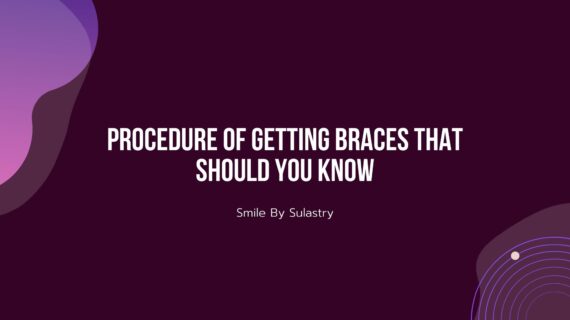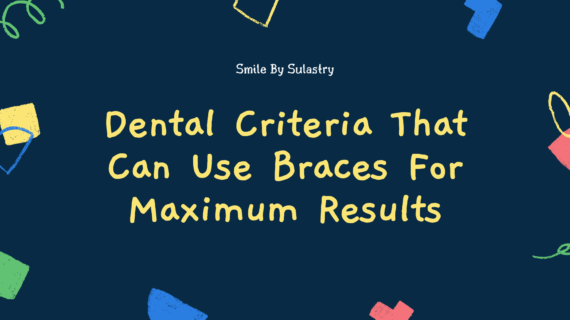Procedure of Getting Braces – Teeth that look less neat, not only make your face less attractive, but also save oral health problems. Using braces or braces is one solution for you. This article will discuss the procedure of getting braces.
The benefits of using braces cannot be said to be trivial. Starting from tidying the position and arrangement of the teeth, flattening the position of the upper and lower teeth, overcoming speech impediments, difficulty chewing and gum disease, and tooth decay.
The use of braces, as part of an orthodontic procedure, will cause pain especially at the beginning of use. Usually more pronounced in the wearer of permanent braces, rather than those that can be removed.
However, there is no need to worry too much when orthodontists recommend that you use braces. With professional treatment and advice from an orthodontist, the pain caused by using braces can be minimized.
Also Read Tips For Relieving Toothache Due to Braces
Procedure of Getting Braces
1. Consultation with a doctor
Before installing braces, you must first consult a dentist. The dentist will do a physical exam and ask you to take an X-ray to see the condition of your teeth. From the results of the examination, the dentist will assess whether you need braces or not.
The dentist will discuss with you the appropriate treatment options and an estimate of how long therapy will take. After that, make an appointment for your next braces.
2. Installation of Braces
Before you attach your braces, the surface of your teeth will be cleaned, smoothed and dried so that they adhere properly. The glue gun will then be applied to the surface of your teeth. After that the braces will be prepared.
On braces, there are brackets that serve as ‘anchors’ for braces. The brackets will also be glued together, then affixed to the teeth in the designated places. The excess glue will be removed. The glue will be exposed to high-strength light, which will make the glue hard, so the braces don’t come off easily.
This process takes approximately 15-30 minutes depending on the severity of your teeth.
3. How You Feel During the Process of Attaching The Braces
After using braces, you will feel uncomfortable because the removal of the braces will be painful especially 4-6 hours after the procedure is over. The pain will last for 3-5 days and after that it will begin to lessen. You are also advised to eat soft foods so as not to cause excessive pain. The doctor will provide pain relievers to reduce pain.
4. Must Do Routine Control
Routine control to the dentist needs to be done for those of you who install braces. Over time, braces can become loose, leaving them with insufficient strength to reposition your teeth. Therefore, it is recommended that you regular control to see the progress of your teeth as well as to tighten your braces every 5-10 weeks depending on the type of braces you use.
If you use a modern model of braces it has better durability so it does not require routine control that is too frequent.
5. Removal of Braces and Care After Removal
After the dentist confirms that the therapy has been completed, the braces will be removed. Slowly the hard glue will be broken down carefully. The remaining glue that is still attached to the tooth surface will be carefully cleaned.
After removing the braces, you are required to use a device known as a retainer. This tool is used in the mouth to prevent your teeth from returning to their original position. The retainer must be used for 6 months without being removed, after 6 months you can use the retainer at night only while sleeping.
Causes of Pain When Using Braces
The pain caused by the installation of braces is one of the things that can get in the way, as well as create a patient’s reluctance to continue treatment. Pain is one of the most dreaded things when someone wants to do or perform braces. Various pains expressed by patients wearing braces, among others, are described as feeling pressure, tension, pain and aches in the teeth.
The cause of pain due to the use of braces is not yet known with certainty. However, one study suggests that the discomfort may be due to changes in blood flow to the teeth due to pressure from braces.
In addition, the friction of braces and complementary instruments with the soft tissues in the mouth can cause pain. Even so, over time, the network will adapt so that braces users feel more comfortable.
Tips to Reduce Pain Due to Using Braces
Reporting from the Alodokter Page, Some of the ways you can do to reduce the pain caused by using braces are as follows:
- During the first few weeks of using braces, you can use orthodontic wax to avoid wounds. Use it when you feel uncomfortable. Remove the wax from the package on your finger, then place it on any part of the braces that feels sharp or prickling.
- Choose soft foods that don’t need to chew a lot during the first few days after braces. The pain will mainly be felt in 1-3 days from use.
- Avoid acidic drinks and foods. The citrus content in it can worsen the condition of mouth sores or trigger more pain.
- Avoid hard or sticky foods, as they can damage braces and cause irritation. Also avoid biting hard objects such as pens, pencils, and ice cubes
- Chewing gum will increase blood flow to the mouth and gums, which can help relieve discomfort.
- Cold foods such as ice cream can provide an immunity which reduces pain. In addition, you can place an ice cube on the painful area.
- If necessary, ask your doctor to provide pain relievers such as paracetamol or ibuprofen.
That was the discussion about the Procedure of Getting Braces and things related to braces. Hopefully this article was very useful!

